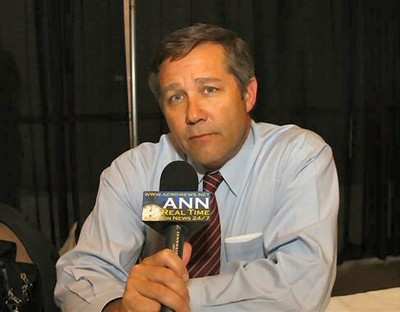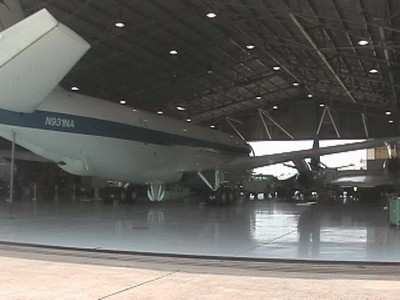Says Public Needs To Be Aware Of Tremendous Implications
ANN spoke with the Aircraft Electronics Association's (AEA) vice
president for government and industry affairs Ric Peri
(below) about the FAA's latest proposal to change FAR Part
145 repair station requirements. This would be the
second major rewrite of the regulation in five years and some in
the industry are scratching their heads wondering why the agency is
doing it again so soon.

Under the previous change proposal to FAR Part 145 completed in
2001, proposed new rating and quality systems raised so many
questions during the public comment period the FAA eventually
dropped them from the final change. Guess what... now they're
back.
We asked Peri to outline the proposed changes for us. He says
they are in two major areas: the way the FAA classifies aircraft a
repair station may work on, and how a station manages and documents
the quality of those repairs.
Peri says the new repair station rating system is good in a
number of ways. The FAA wants to eliminate the concept of
"airframe" in favor of "aircraft." An airframe rating was clearly
defined and limited the station to specific parts of an aircraft.
An aircraft rating would give the holder broader authority.
Additionally, the FAA wants to eliminate the limitations based on
weight and construction materials.
There are proposed changes to the powerplant ratings as well.
Gone would be the high and low-horsepower classifications. Instead,
stations would be rated for single-engine reciprocating,
single-engine turbine or APU.
Propellers, avionics and components will all become single
ratings.
Under the FAA proposal a single organization may now maintain
two facilities within the same district without requiring two
certificates. There are also beneficial changes to satellite repair
station and sub-contracting rules.
But not all in the proposal is champagne and caviar. Peri told
ANN, "One of the good things is the new ratings; the bad thing is
in the implementation of it."
Under the proposal, the FAA would like to create a "type-rating"
system. Peri says the preamble to the proposal specifically says "a
Boeing 757 is not like a Boeing 737" and a station rated for one is
not necessarily rated for the other. The fear is the FAA will take
that to the extreme and require type-ratings for different models
of GA aircraft -- a repair station working on Cessna 170 series
would need ratings for the 170, 172, 175 and 177.
 As Peri notes, for an
airline or large maintenance organization dedicated to supporting
only a few airframes, type-ratings for the station isn't a terribly
onerous change. "When you look at it with one set of glasses, it
fits; until you add the other set. When you add the [general
aviation] glasses and you realize a small repair station today that
has a Class III airframe rating would need upwards of 200 type
ratings to continue operations it gets onerous in a heartbeat!"
As Peri notes, for an
airline or large maintenance organization dedicated to supporting
only a few airframes, type-ratings for the station isn't a terribly
onerous change. "When you look at it with one set of glasses, it
fits; until you add the other set. When you add the [general
aviation] glasses and you realize a small repair station today that
has a Class III airframe rating would need upwards of 200 type
ratings to continue operations it gets onerous in a heartbeat!"
If implemented as Peri fears, the FAA's proposal could become a
huge issue for owners of older or not-so-popular aircraft. Owners
of smaller shops with only one or two mechanics might not have the
time or dollars needed to get rated for all the different
types, so they might concentrate on only those types based at their
airport, and add only those most likely to show up. "Imagine
dropping into an airfield for fuel only to realize you need a tire
changed. That repair station has to have that particular type
listed in their operation specifications (OPSPEC) in order to
perform maintenance on it."
Also up for change is the "limited" aircraft rating. Under the
current rules, specialty shops like fuel tank repair, small
avionics shops, aircraft cleaning (as a function of corrosion
control) can apply for a limited rating allowing them to work only
on a specific area of the airframe. Specialty maintenance providers
like this have been moving to a mobile environment in which
a businesses of this type might maintain a central location --
often not a hangar -- with the workers traveling to and using the
client's facilities to perform the work. It's a great way for
everyone to benefit; the client doesn't have to move the aircraft
and the business owner doesn't have to maintain a facility.
Under the new proposal each repair station must maintain a
facility large enough to house the largest aircraft it may work on
under its OPSPEC. "The proposal that every facility has to have its
own 'brick and mortar' is a dated, legacy business model," says
Peri, adding it will limit options for small businesses. "Imagine a
fuel cell repair business that specializes in airliner repairs.
They go to their customer's facility to do the work. Now they must
have their own facility large enough to house that airliner?" And
the part that's making Peri and many small business owners scratch
their heads? Even though an organization must have the facility to
house a large aircraft, they don't have to use it -- the proposal
specifically allows technicians to work remotely!
The other major issue Peri has with the FAA's proposal is the
new quality assurance standards. The proposal outlines a system of
internal audits which would help a large, multi-tiered organization
with many levels of supervision -- like an airline -- track and
manage procedural changes and documentation. But, says Peri, it's a
system that translates poorly to the one-man repair stations
ubiquitous in the GA community.
Peri said, "How do you audit yourself, having to audit the
repair manual you just wrote to identify the discrepancies; to
correct the discrepancies; to re-audit that you corrected the
discrepancies that you found the first time around?" It's a
ridiculous requirement in that situation says Peri, and it's a
situation not addressed by the proposal.

What's more, says Peri, is a proposed change in a requirement to
publish a "letter of compliance." Currently, stations must write a
letter which basically says they will comply with FAR Part 43
standards by implementing a quality program. Under the new
proposal, each facility must outline in their letter specific
procedures they'll follow to meet Part 43 standards -- the same
procedures already outlined in the station's supposedly
FAA-approved repair manual. "It's redundant paperwork," says
Peri.
Peri's take on the proposal adds up to a enough paperwork to
make a seasoned attorney go snow blind. "[FAA] headquarters is
reintroducing a major change requiring a rewrite of the [repair
station manual], essentially an entirely new quality manual, and
the submission of these letters of compliance on top of major
changes to the [station's] training program," said Peri.
Peri says many haven't considered the FAA's workload -- it's
going to be of major import to everyone if this proposal is
implemented. "The FAA hasn't completed reviewing all the repair and
quality manuals and training programs rewritten under the last
change," he says, "And what's worse, the new proposal outlines no
compliance time lines."
"Are repair stations out there today holding Class ratings going
to be grand-fathered and given all the type ratings in their
OPSPECs? Does the entire maintenance industry shut down at the
stroke of midnight and reapply for type ratings? None of this is
clear," warns Peri.
 This issue hasn't gotten
the attention it deserves according to Peri. "It isn't getting a
lot of public notice, but it has tremendous implications," he said,
adding most people not involved in the industry haven't considered
the impact the proposal might have on their time or pocketbooks.
He's urging everyone to get as educated as possible.
This issue hasn't gotten
the attention it deserves according to Peri. "It isn't getting a
lot of public notice, but it has tremendous implications," he said,
adding most people not involved in the industry haven't considered
the impact the proposal might have on their time or pocketbooks.
He's urging everyone to get as educated as possible.
The AEA website contains the latest up-to-date information on
the status of the proposal replete with suggested reading to help
everyone bone up on the issues. You'll also find helpful links to
the appropriate docket number in the Federal Register where you'll
find instructions on how to ensure your voice is heard during the
public comment period.
 Classic Aero-TV: The Switchblade Flying Car FLIES!
Classic Aero-TV: The Switchblade Flying Car FLIES! ANN FAQ: Q&A 101
ANN FAQ: Q&A 101 ANN's Daily Aero-Term (04.12.24): Discrete Code
ANN's Daily Aero-Term (04.12.24): Discrete Code ANN's Daily Aero-Term (04.13.24): Beyond Visual Line Of Sight (BVLOS)
ANN's Daily Aero-Term (04.13.24): Beyond Visual Line Of Sight (BVLOS) ANN's Daily Aero-Linx (04.13.24)
ANN's Daily Aero-Linx (04.13.24)






